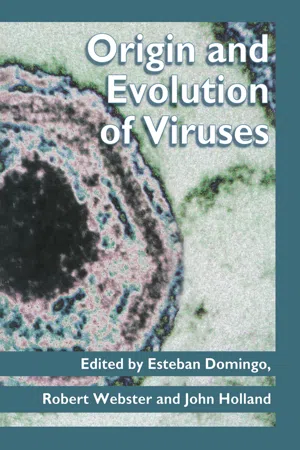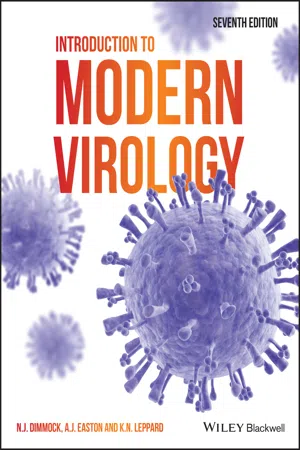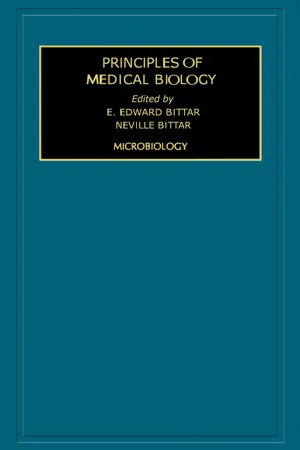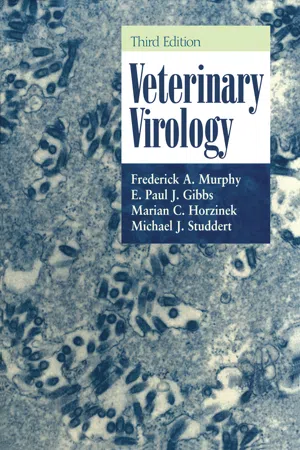Biological Sciences
Antigenic Shift
Antigenic shift is a process in which the genetic material of a virus, particularly influenza viruses, undergoes a major change, resulting in the emergence of a new strain. This can occur when two different strains of the virus infect the same host and exchange genetic material, leading to a novel virus with the potential to cause widespread illness.
Written by Perlego with AI-assistance
Related key terms
1 of 5
6 Key excerpts on "Antigenic Shift"
- eBook - ePub
RNA Genetics
Volume III: Variability of RNA Genomes
- Esteban Domingo(Author)
- 2018(Publication Date)
- CRC Press(Publisher)
1 subtype viruses infecting humans in 1950. Consequently, for this Antigenic Shift the emergence of a dormant virus from an unknown depot seems to have occurred.Antigenic Shift occurs unpredictably at intervals of about 40 (1918 to 1957), 10 (1957 to 1968), and at least 18 years (1968 to the present) from direct observation, and indirectly, from serological studies, at a similar interval in the last century (1890 to 1899).23 Interestingly, the HAs of the viruses involved in the two late 19th century Antigenic Shifts may also have belonged to the H2 and H3 subtypes, but the significance of this apparent restriction is not known. The main property of the HA which might influence the ease of interspecies transfer is receptor binding specificity, which certainly differs between the HAs of viruses isolated from humans and those from birds and horses24 and might limit the number of HAs which can successfully change their tissue tropism from avian intestinal epithelium cells to the respiratory epithelium of humans.III. ANTIGENIC DRIFTAntigenic drift describes the progressive change in antigenic properties which occurs with time after the introduction of a new subtype into the human population. Convincing evidence for the process is only available for human influenza, although there are suggestions that it may also occur in horses.13 Routinely, the changes in HA antigenicity are analyzed in hemagglutination inhibition tests using convalescent ferret antisera which are highly strain specific and show clearly the relationships between viruses isolated in different years.25 Recently, these analyses have been accompanied by studies of the nucleotide sequences of the RNA genes for HA of representative isolates26 , 27 , 28 , 29 , 30 and the results obtained indicate that antigenic drift results from the accumulation of amino acid substitutions in one of the two glycopolypeptide components of the HA subunit. Hemagglutinins are trimers of moleculai weight of about 220,000, in which each monomer consists of two disulfide-linked glyco polypeptides HA, and HA2 . The three-dimensional structure of the 1968 Hong Kong virus HA is known to 3 Å resolution.31 The molecule is a 135-Å-long cylinder, approximately triangular in cross section, and varying in radius from about 15 to 40 Å. The HA, chain of each subunit extends from the base of the molecule at the virus membrane through a fibrous stem to a distal region rich in β-structure and composed exclusively of HA, residues. It then returns to the fibrous region of the molecule and terminates about 30 Å from the virus membrane (Figure 1 ). The most prominent features of the part of the subunit composed of HA2 residues are two antiparallel α-helices, one, 29 Å long, which proceeds distally beginning about 30 Å from the membrane to connect with the other helix which is 76 Å long and stretches back to within 20Å of the membrane. These helices are the main components of the central fibrous stem of the molecule which supports the globular membrane distal HA1 - eBook - PDF
- Esteban Domingo, Robert G. Webster, John F. Holland(Authors)
- 1999(Publication Date)
- Academic Press(Publisher)
378 R.G. WEBSTER B virus gene pool except in humans; conse- quently, genetic shift is not found in influenza B viruses. Other mechanisms for producing genetic variation include defective-interfering particle- mediated interference and intermolecular recombination. Although defective-interfering particles can influence evolution by reducing the yields of non-defective particles and modi- fying pathogenicity (Steinhauer and Holland 1987), their role in influenza virus evolution has not received much attention. Although inter- molecular recombination in negative-stranded viruses is rare, studies have demonstrated that it does occur (Khatchikian et al., 1989). This pro- vides another mechanism for providing rapid evolutionary changes. VARIATION: ANTIGENIC DRIFT AND GENETIC SHIFT The influenza viruses are unique among the res- piratory tract viruses in that they undergo sig- nificant antigenic variation. Both the surface antigens of the influenza A viruses undergo two types of antigenic variation: antigenic drift and genetic shift (Murphy and Webster, 1996). Antigenic drift involves minor antigenic changes in the HA and NA, whereas shift involves major antigenic changes in these mole- cules resulting from replacement of the gene segment. Antigenic Drift Antigenic drift occurs in both the HA and NA of influenza A and B viruses. The structure of both of these glycoproteins is established and the antigenic domains surround the conserved receptor binding site on the HA and the enzyme active center on the NA (Colman, 1989; Wiley et al., 1981). The detailed structure of one of these epitopes on the N9 NA was established by crys- tallization of the Fab fragment of monoclonal antibody (NC41) and comprises five peptide loops located at the rim of the enzyme active site (Tulip et al., 1992). Five antigenic domains (A-E) have been defined on the HA1 by comparative sequence analysis. - eBook - PDF
- Nigel J. Dimmock, Andrew J. Easton, Keith N. Leppard(Authors)
- 2015(Publication Date)
- Wiley-Blackwell(Publisher)
At the same time, the ‘old’ strain is less likely to find a susceptible person to infect so the proportion of people infected with this virus Chapter 20 Influenza virus infection 315 Fig. 20.4 Diagram showing antigenic drift of type A influenza virus in humans. This could represent mutations within either the HA or NA genes. Each point is a virus strain isolated in a different year. declines. The result is that the ‘old’ strain is rapidly and completely replaced by the ‘new’ strain. Influenza B viruses also undergo antigenic drift, but this is slower process. Currently, two distinct genetic lineages of influenza B virus are circulating in the human population. These belong to the B/Victoria and B/Yamagata lineages that are antigenically distinct and diverged from each other in the 1980s. The reason for the differences in the pattern of antigenic drift of influenza A and B viruses is not known. As soon as a new shift virus appears and infects people, it begins to drift (Fig. 20.5). Drift happens on a global scale. Antigenic drift of influenza A viruses is linear due to the dominating effects of favourable mutations (Fig. 20.6). It can only be theorized how drift takes place as it is assumed that drift variants arise from virus circulating in the previous year. It is generally believed that variants are selected by antibody (Box 20.2). The phenomena of Antigenic Shift and drift in influenza have significant implications for human infection and they are monitored by a worldwide network of laboratories, coordinated by the WHO, that isolate and classify currently circulating influenza viruses. In this way, new strains can be quickly spotted and the vaccine changed appropriately. 20.2 Influenza virus replication The processes of influenza virus entry (Section 6.2), replication (Section 8.5), gene Fig. 20.5 Diagram showing the course of Antigenic Shift and drift of influenza A viruses in humans. - eBook - PDF
Viruses
Agents of Evolutionary Invention
- Michael G. Cordingley(Author)
- 2017(Publication Date)
- Harvard University Press(Publisher)
Within each antigenic cluster, substantial sequence evolution can occur, much of which is relatively silent antigenically. Thus, sequence evolution continues at a steady pace but is associated with little, perhaps subtle, phenotypic change. On the other hand, some antigenic clusters were separated by single ground-shifting mutations with profound effects. The rate of evolution between clusters was shown to be higher than within clusters; it is during the transition from one cluster to another that antigenic evolution occurs most quickly. Since this seminal work was published, further studies have interro-gated H3N2 evolution within and between epidemic years, but also in the The Flu: No Common Cold · 105 context of geographical and epidemiological data (Holmes et al. 2005; Nelson et al. 2006). The analysis of H3N2 circulating in local epidemics revealed that multiple sequence clades of the virus commonly circulate in each epidemic season. A further layer of complexity is evident in that these co-circulating clades commonly reassort with each other, providing yet another basis for the creation of genetic diversity within the circu-lating influenza virus population. This phenomenon, when it involves reassortment between different viral subtypes, is responsible for Antigenic Shift and the creation of pandemic influenza viruses. Now it was recog-nized as a common phenomenon contributing to evolution of circulating seasonal influenza viruses within an epidemic. Such intratypic reassort-ment is associated with increased rates of amino acid substitutions in viral genes (Holmes et al. 2005; Neverov et al. 2014). The precise genome background of each influenza virus gene segment influences its fitness. Gene segments within the same virus are under selective pressure to undergo evolutionary coadaptation for optimal virus fitness. - eBook - PDF
- Edward Bittar(Author)
- 1998(Publication Date)
- Elsevier Science(Publisher)
In the other two diagrams the circles indicate the positions where prior changes had occurred and the triangles show the positions where additional amino acid substitutions accumulated during the indicated time periods. ing the strains which will cause future outbreaks and of selecting antigenically appropriate viruses for use as vaccines. Logic suggests that antigenic drift is driven by immune selection of changes in the regions of HA recognized by neutralizing antibodies. Although some changes selected will not be present in future outbreaks—an evolutionary dead end—others will become fixed in the HAs of viruses isolated from future outbreaks and define the lineage of antigenic drift. Explanations of how human populations can become reinfected year after year are incomplete since the HA does not normally change every year in all regions recognized by neutralizing antibodies. One possibility is that mutations in the different antigenic regions are selected sequentially because individuals in the population normally develop only partial immunity during infection (Wang et al., 1986). The neuraminidase glycoprotein, like the HA, participates in Antigenic Shift and undergoes rapid antigenic drift (Martinez et al., 1983; Colman et al., 1983). Sequence data on NA of isolates of the N2 subtype indicate that variation occurs predominantly in seven loops which have been identified in the crystal structure of the NA heads (Colman et al., 1983). Although anfibodies against NA do not inhibit virus entry into cells, they can offer some degree of protection against Viral Membranes 345 subsequent infection (Webster et al., 1988) by limiting the release of viruses from infected cells and hence the spread of virus from cell to cell. Analyses of the crystal structures of NA-monoclonal antibody Fab complexes have contributed extensively to understanding the molecular basis of antibody-antigen interactions. - eBook - PDF
- Frederick A. Murphy, E. Paul J. Gibbs, Marian C. Horzinek, Michael J. Studdert(Authors)
- 1999(Publication Date)
- Academic Press(Publisher)
Every 10-20 years a reassortant virus from the pig, containing genes encoding replicative func- tions from a human virus and a hemagglutinin gene derived from an avian virus, emerges. It might be argued that the chances of this happening again must be van- ishingly small, but it must be appreciated that in rural Genetic Variation and Viral Evolution 79 southeast Asia, the most densely populated area of the world, hundreds of millions of people live and work in close contact with domesticated pigs and ducks. It is no coincidence that the last two Antigenic Shifts that have produced major pandemics in humans emanated from China. However, not all new influenza viruses in mam- mals arise by reassortment between a preexisting mam- malian strain and an avian virus. For example, the HIN1 swine influenza virus strain that appeared in Europe in 1979 was derived directly from birds, and the equine H3N8 influenza virus that appeared in northern China in 1989 was very different from the H3N8 equine influenza virus currently found elsewhere in the world, but very similar to an avian H3N8 influenza A virus. An impor- tant additional example of host species jumping without genetic reassortment occurred in 1997 in Hong Kong (see later). Genetic/Antigenic Drift After a new pandemic influenza virus strain has emerged as a consequence of genetic reassortment, antigenic drift begins when point mutations accumulate in all of its RNA segments (Figure 4.8). Mutations in the gene en- coding the hemagglutinin sometimes alter its antigenic sites. When antiserum against the formerly prevalent strain no longer neutralizes the variant, a new strain has emerged. Changes in the hemagglutinin are clustered in five regions of the molecule, which correspond to important antigenic sites. Substitution of a single amino acid in a critical antigenic site may abolish the capacity of the antibody to bind to that site.
Index pages curate the most relevant extracts from our library of academic textbooks. They’ve been created using an in-house natural language model (NLM), each adding context and meaning to key research topics.





